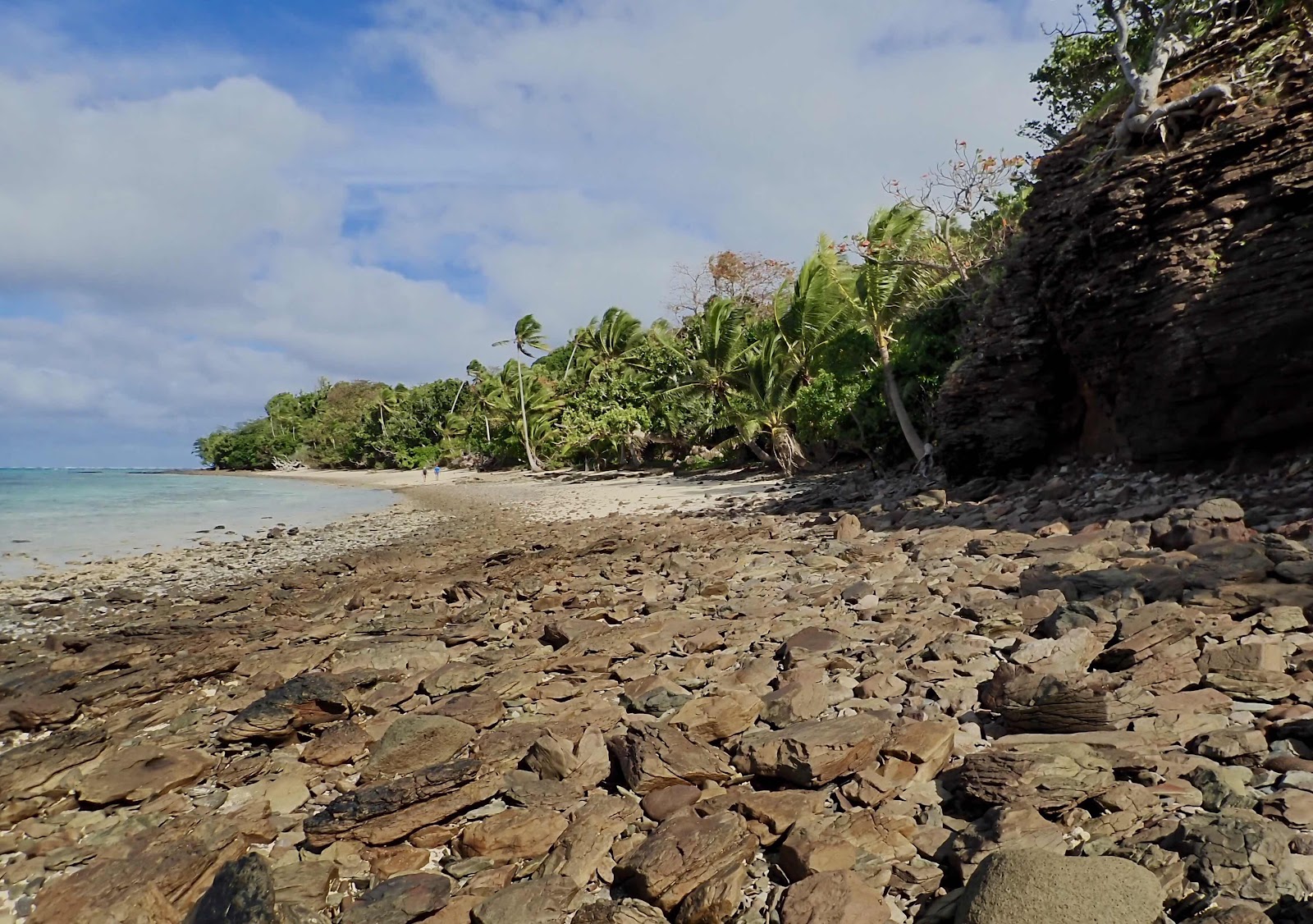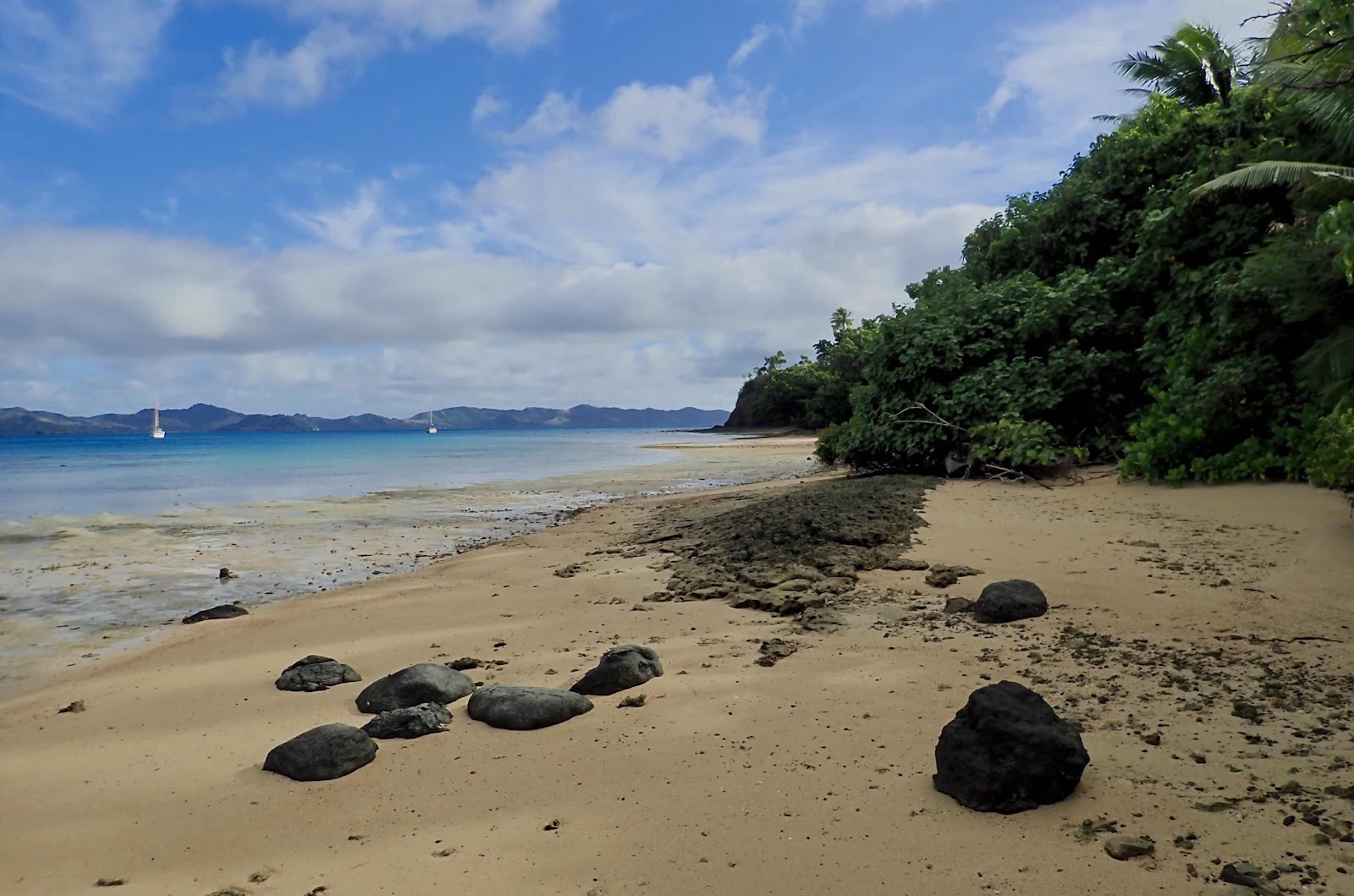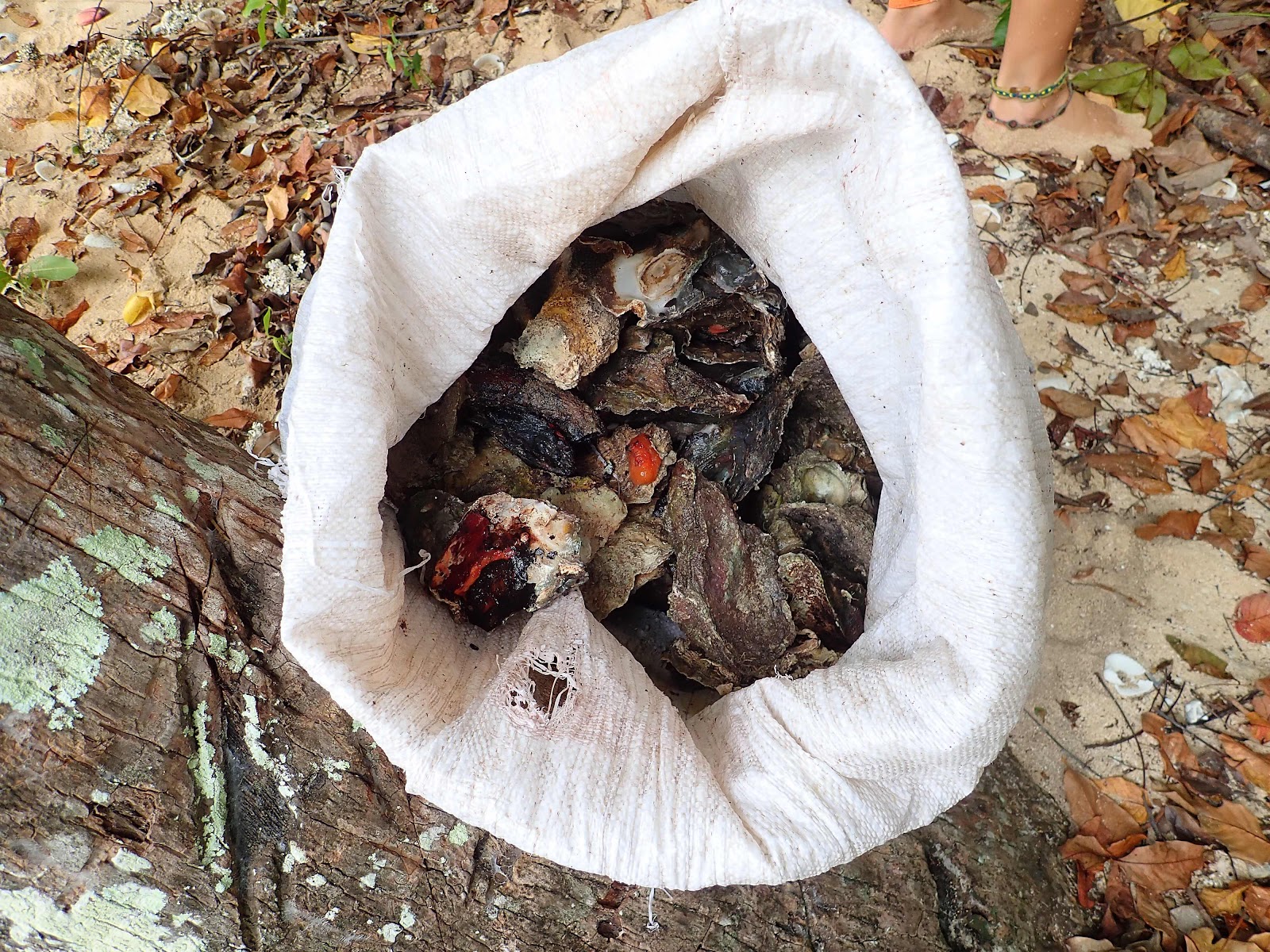Matangi Island. We were allowed to swim and kayak in the bay, but not go ashore.
Following the path signs round the top of the crater - we diddn’t come across any wild pigs!
After a couple of days in Matangi we set off for Vanua Balavu, the most northerly of the Lau group of islands. We had heard such glowing report of the place it was going to be hard for it to live up to expectations. We entered the lagoon through a small gap in the reef and carefully made our way down to the town of Dalitoni where we were to present our Cava and do the Sevusevu ceremony with the village chief before visiting the island. One of the yachts that had been stuck in Minerva Reef with us had very recently hit the reef outside Dalitoni so we were proceeding with even more caution than usual!
The yacht Acapella on the reef outside Dalitoni - another reminder not to trust the Chartplotter! Amazingly, with the assistance of the villagers and two other yachts they managed to pull Acapella off the reef that night at the next high tide, in complete darkness. Even more astonishingly apart from smashing the rudder there was only cosmetic damage - the rudder was later removed in a calm anchorage and rebuilt by Eva from the yacht Atla using home made play doh and covering it with fibreglass. The temporary repair got them safely to Suva, 160 Nm away, where they had the yacht lifted and a more permanent rudder built. The locals are now naming it The Acapella Reef.
The village of Dalitoni had taken a direct hit from Cyclone Winston in 2016 and much of it had been rebuilt - unfortunately for them the Vodaphone Mast had been destroyed and they were still waiting for repairs. Internet was unavailable unless you took the thrice weekly ‘bus’ to the main town of Lomaloma on the other side of the island.
Dalitoni Village - approximately 125 people live here, the main source of income is fishing although when we asked to buy fish, none was available.
The village store - tinned fish, milk powder, rice and instant noodles are the main staples.
The villagers are very self sufficient, most grow their own vegetables - this is Taro, the leaves grow to about 1metre across - the whole plant is eaten, including the very dense, bland white roots which are the local alternative to potatoes.
The only airport on Vanua Balavu is an hour’s walk outside Dalitoni - there is only one flight a week. We walked there with Bernt and Birgit from Rebell.
The next day we braved the ‘bus’ to Lomaloma, the main town on the island with approximately 200 inhabitants and more importantly for us, a slightly larger shop where we could buy a local Digicell SIM card. The bus was an hour later than expected, and absolutely packed - literally standing room only, there didn’t seem to to be official bus stops, and just after it set off on the return journey someone wanted to return to the shop for an ice cream so the bus reversed back up the single dirt track to the shop accompanied by much shouting and general hilarity.
The local children enjoyed showing us round the village, they keep pigs and as usual there are chickens roaming free - although the quicker of the children could catch them, the locals don’t keep them for eggs. Eggs come by boat from Suva - the first lot we bought must have come from Suva several months ago; it was not a pleasant experience breaking into one!
Having spent the afternoon with the children, they then asked if they could come and have a look at Nautilus - they were very well behaved but I sas still very glad that we had Sara, a ‘responsible adult’ from the village with us to keep them under control.
‘School Outing’ to Nautilus, with Sara keeping the children under control.
A Google Earth screen shot of Vanua Balavu, our track shown in red. We entered the reef through the pass in the north, heading first down the west side of the island, back up through the Bay of Islands and then over the top and on to Avea Island, a quick stop in Lomaloma for some supplies and our current location on the southern tip off the village of Suisui. The arrow shows our intended route out through the reef.
The highlight of Vanua Balavu is reputed to be the Bay of Islands - it really was beautiful: dozens of mushroom shaped lava plugs, many heavily forested, forming a huge and beautifully calm anchorage.
We explored by Kayak. Vanua Balavu certainly lived up to it’s reputation - it was stunning.
Under water in the Bay of Islands. It’s hard to believe it’s real.
We spent 4 days in the Bay of Islands before threading our way through the islets, round the top of Vanua Balavu and on to Bavatu Harbour, which is not really a harbour at all. Bavatu is a large inlet only accessible by boat, the land owner, Tony also owns Vuda Point and Copra Shed Marinas and is in the process of rebuilding a very small yacht club in the bay, free for the use of visiting yachts. He has a beautiful house on the hill overlooking the bay and employs a team of locals to look after the 100 sheep, 7 horses, 30 or so cows, pigs and chickens he keeps basically as pets.
The sheep are a self-shedding variety, their fleece falls out naturally so no shearing is needed. Walking through the farm with Bernd and Birgit from Rebell.
The view over Bay of Islands - we’d been anchored at the far left of the bay, probably just out of shot from this point.
We left the main island of Vanua Balavu for Avea, 8 Nm away and still within the main outlying reef area. Avea had been badly hit by the 2016 Cyclone Winston - the corner of the island, including the local school, had been effectively washed away. We were told a graphic tale of how the head teacher and his family had sheltered in the collapsing building, unable to brave the winds to get ashore. Fortunately apart from one girl cut by flying debris there were no injuries during the cyclone.
A small corner of one of the classrooms still stands in the sea - even the area where the head teacher sheltered has now been claimed by the waves.
A vast new school and kindergarten are very slowly being built, apparently paid for by foreign aid from Japan. The locals told us that each household is given FJ$7,000 (just over £2,000) to rebuild but many of them are still waiting for the money two years down the line and they have all now rebuilt using salvaged materials.
After Avea we made a quick re-provisioning stop in Lomaloma and then headed to our final Vanua Balavu destination, Suisui back on the main island. The town has a population of about 80 people, of which 20 are primary school aged children. This part of the island is only about 250 metres wide, we walked across the island and were able to walk back round the coastline at low tide.


A coastal walk - only possible at low tide.
There are absolutely massive trees growing right up to the water’s edge - these ones presumably casualties of the cyclone, but there are plenty still growing well seemingly out of the sand.
Since we have been in Fiji we have been given a couple of Nautilus shells, but this was the first time we have actually found an intact one ourselves.
When we got back to the village a young girl was removing the husks from coconuts with great ease and efficiency - it took her about 30 seconds and she certainly didn’t break a sweat. Ian had a go - a good 5 minutes and considerable effort later the coconut was finally extricated from the husk.
There are 5 yachts in the bay, including us and The Rebells, and several of us went along with the village spokesman, Joseph, for a Fiji style bbq on the beach in a nearby ‘hidden lagoon’. We were dropped off on the beach and the 4 locals went off to collect oysters from the mangroves and hopefully catch a few fish.
On their return a fire was lit, the oysters briefly placed in the embers to facilitate the opening, flicked out with a stick and then broken open. Still raw, they were rinsed and covered with lemon juice and chilli. 


Apparently they were very good - I declined to try one.
The fish were much more to my taste - surprisingly good considering they were simply chucked on the flames and flicked out with a stick when they were totally charred and black. The ash and charcoal was washed off in the sea, and again they were served with lemon juice - delicious, if a little tricky to eat as no cutlery or plates were involved in the process.
You an just make out a fish in the top photo, Joseph and another fisherman are washing the fish in the sea.
This was far more to my taste - I’d asked Joseph if I could buy some fruit and this is how he delivered it, in a palm leaf basket.
Wash day in Suisui village - these are all school uniform shorts hanging on the line.
Tomorrow is Sunday and we have been invited to go to church and have lunch with Joseph and his family - weather permitting we will leave for an overnight passage to Fulanga at the southern end of the Lau group on Monday, as usual it is important to arrive in daylight and preferably at slack tide for the entry through the pass in the reef.
As usual, we have been diving here - the photos above are a close up of some coral, a jelly fish caught by an anemone, a clam and some soft coral.
Our anchorage in Suisui, and Joseph’s wife weaving a new mat for their porch. The work is done sitting on the floor - they can sit cross legged for hours with no discomfort at all and find it amusing that most of us can’t!
Next stop: Fulanga, then heading on towards Suva the main town on Viti Levu.
